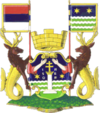Rumā
|
Ruma Рума |
||
|---|---|---|
| Town and municipality | ||

City square
|
||
|
||
 Location of the municipality of Ruma within Serbia |
||
| Coordinates: 45°00′N 19°50′E / 45.000°N 19.833°ECoordinates: 45°00′N 19°50′E / 45.000°N 19.833°E | ||
| Country |
|
|
| Province | Vojvodina | |
| District | Srem | |
| Settlements | 17 | |
| Government | ||
| • Mayor | Sladjan Mancic (SNS) | |
| Area | ||
| • Municipality | 582 km2 (225 sq mi) | |
| Population (2011 census) | ||
| • Town | 30,076 | |
| • Municipality | 54,339 | |
| Time zone | CET (UTC+1) | |
| • Summer (DST) | CEST (UTC+2) | |
| Postal code | 22400 | |
| Area code | +381 22 | |
| Car plates | RU | |
| Website | www |
|
Ruma (Serbian Cyrillic: Рума) is a town and municipality located in the Srem District of the autonomous province of Vojvodina, Serbia. In 2011 the town had a total population of 30,076, while Ruma municipality had a population of 54,339.
Traces of organized human life on the territory of Ruma municipality date back as far as the prehistory. The most important archaeological locality in the municipality is Bronze Age Gomolava near Hrtkovci, with two exclusive tombs of Bosut culture dating to 9th century BC and 3000BC Vučedol culture pottery. First known inhabitants of this area were various peoples of Illyrian and Celtic origin, such as the Amantini, Breuci, Scordisci, etc. During Roman rule, local inhabitants lost their ethnic character and adopted Roman culture. There were no larger Roman settlements on the territory of Ruma, but a certain number of agricultural estates known as "villae rusticae" were located there.
Migrations of Huns, Germanic peoples, Avars and Slavs destroyed the Roman culture in this area. During the following centuries, the region was ruled by Frankish Empire, Bulgarian Empire, Byzantine Empire and Kingdom of Hungary.
The settlement named Ruma was first mentioned in an Ottoman defter from 1566/7. In that period Ruma was a village inhabited by Serbs, with 49 houses a church and three priests.
...
Wikipedia

